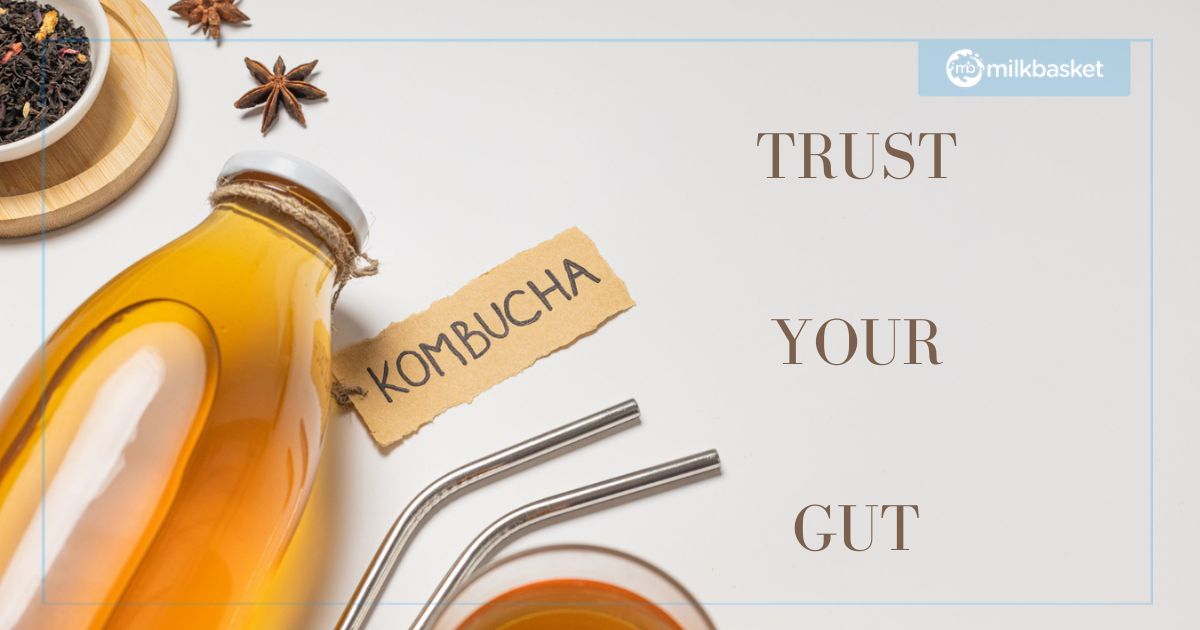Kombucha - What Is It? How Is It Made? Why Is It Beneficial?
Kombucha is a type of fermented tea that has become increasingly popular in recent years due to its potential health benefits. It is made by adding a symbiotic culture of bacteria and yeast (referred to as a “SCOBY”) to sweetened black or green tea, and allowing the mixture to ferment for about a week.
During the fermentation process, the SCOBY consumes the sugar in the tea and produces various organic acids, enzymes, and probiotics, which give kombucha its characteristic tangy flavor and fizzy texture. Some of the potential health benefits of drinking kombucha include improved digestion, immune support, and detoxification, although these claims are not yet fully supported by scientific research.
Kombucha can be purchased bottled in many grocery stores, health food stores, and specialty shops, or it can be made at home with a SCOBY and a few simple ingredients. It is important to note that, like any fermented food or beverage, there is a risk of contamination or over-fermentation if not prepared and stored properly.
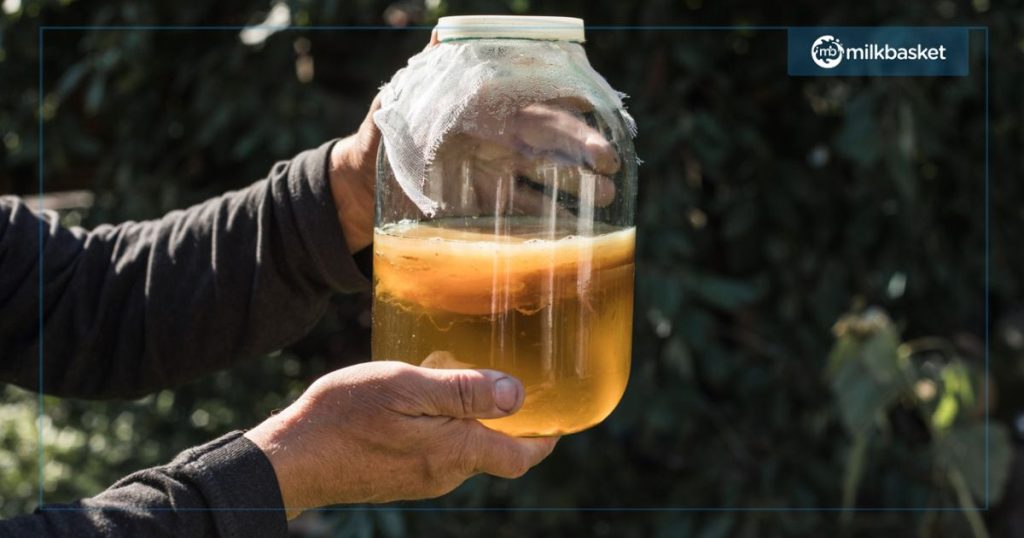
History Of Kombucha
Kombucha is a fermented tea beverage that has been consumed for centuries in many parts of the world. While the exact origins of kombucha are unclear, it is believed to have originated in Northeast China or Manchuria, where it was consumed for its health benefits.
The first written record of kombucha dates back to 221 BCE in China, during the Tsin Dynasty. The beverage was known as the “Tea of Immortality” and was said to have been introduced to Japan by a physician named Kombu around 415 CE.
Kombucha spread throughout Asia and Europe, where it was valued for its medicinal properties. It became particularly popular in Russia during the early 20th century, where it was known as “tea kvass” and was a staple in many households.
In the 1960s and 1970s, kombucha gained popularity in the United States and other Western countries as a health beverage. Its popularity continued to grow in the following decades, and today, kombucha is widely available in health food stores and supermarkets around the world.
While kombucha has a long history of traditional use, scientific research into its health benefits is limited. Some studies suggest that kombucha may have antimicrobial, antioxidant, and anti-inflammatory properties, but more research is needed to fully understand its potential health benefits.
Benefits Of Kombucha
- Has probiotics which are beneficial for the gut. The fermentation helps in creating millions of microorganisms which help in keeping the gut healthy, flourishing and functioning well.
- It is believed that it provides the same health benefits as green tea, which is rich in bioactive compounds, such as polyphenols, which function as powerful antioxidants in the body.
- It is rich in antioxidants and as per studies it cleans up liver toxins up to 70%.
- Can help manage type 2 diabetes. An experiment on diabetic rats showed that kombucha slowed down the digestion of carbs, which reduced the blood sugar levels.
Recipe For Mango Kombucha
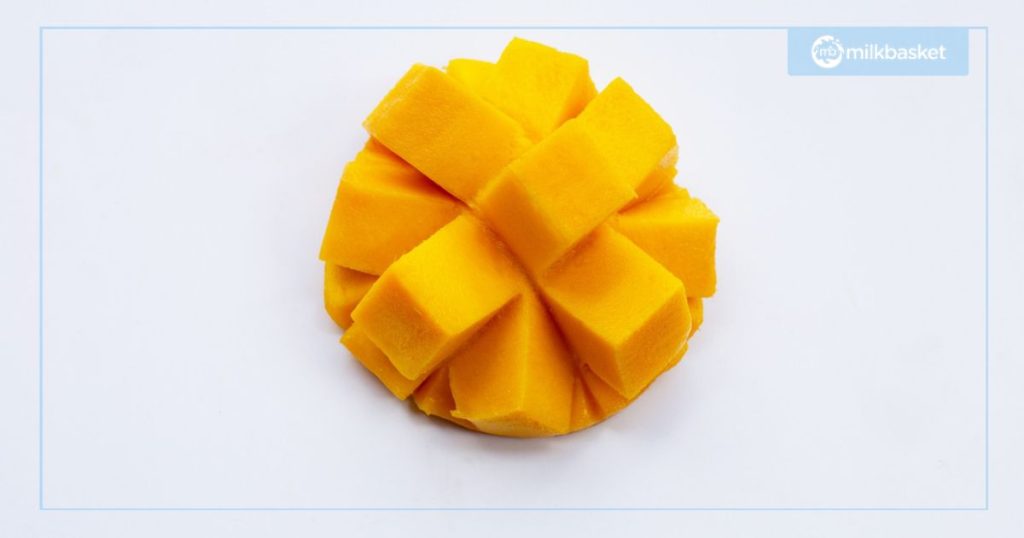
First Fermentation
- 14 cups (3.3 L) clean water
- 1 cup (200 g) white sugar, sulphurless
- 8 bags black or green tea (or 2 Tbsp loose leaf)
- 2 cups (470 mL) unflavored kombucha/ starter tea (either from a previous batch or unpasteurized, unflavored store bought kombucha
- 1 or 2 SCOBYs (depending on how many containers you’re using, 1 per container)
- A large glass container or ceramic (two jars holding at least 1.9 L each, or one jug holding at least 3.7 L. Alternatively, use a glass jug with a built-in spout/spigot to make pouring the kombucha out easier!
- Tightly woven cloth (coffee filters, paper towels, napkins, cheese cloth)
- Rubberbands
Guidelines For The First Fermentation:
- In a clean pot, bring water to a boil. Take it off the heat and stir in the sugar.
- After the water cools to room temperature, add the tea and let it soak (a few hours). Must once more be at room temperature. Avoid exposing your SCOBY to hot water at all costs.
- Remove the SCOBY from the tea and place it on a plate with hands that are AS CLEAN AS A SURGEON’S (very clean), you can also wear gloves. Although it is not required, you can rinse out the jar (without soap).
- The starter kombucha should be added after the sweetened tea has been added to the jar (if using two jars, divide the starter kombucha equally between the two).
- Carefully drop SCOBY into the jar then cover with a couple layers of the tightly wven cloth and secure it with a rubber band.
- Place the jar(s) somewhere quiet, dark, and temperate (21–24 C) for six to ten days. Start tasting the tea after about 6 days by using a pipette or a paper straw to gently extract some of the tea (using your finger to hold the tea in the straw, not your mouth). It ought to have a slight sweetness and a hint of vinegar. The kombucha will ferment more quickly if the air is warmer. Tea loses sweetness as it ferments longer because more sugar molecules are used.
- Save 2 cups from this batch to use as starter kombucha for your next batch (simply leave it in the jar with SCOBY(s)). The remaining portion may proceed to the second and final fermentation.
Guidelines For Second Fermentation:
In the second fermentation, you can add any flavours. Since summers are near, we have decided upon mango, a great fruit that everyone loves.
Ingredients
- 1.9L from first fermentation
- 1 ripe mango about 2 cups frozen (which you should thaw before adding to the kombucha)
Instructions
- Puree: Use a blender to puree mango into a smooth pulp.
- Mix: In a large glass bowl or pitcher, stir together pureed mango and kombucha. You can even add sugar, in case you want extra carbonation. Since mango is sugary enough we won’t be adding extra sugar.
- Bottle: Transfer kombucha into tightly sealed bottles, leaving about 2 inches empty at the top. Seal tightly. ALWAYS BURP (open the bottle every 24 hours) so that you avoid the bottle bursting.
- Ferment: Place in a dark, room temperature area for 2-3 days, until it reaches the carbonation level you like. This process will go faster in warmer climates, and slower in cooler climates.
- Enjoy: Strain the kombucha to remove fibers (optional), then chill in the fridge before serving. Can be stored in the fridge, tightly sealed, for several weeks.
You can buy the tea, sugar and fruit from Milkbasket. The order will come to you packed, sealed and absolutely fresh.
Categories
Popular Posts
-

5 Delicious Types of Tea to Try at Home
Spread the loveMonsoon and tea go hand in hand, don’t they? Imagine sitting by the window, listening to the pitter-patter of raindrops, and sipping on a hot cup of tea – pure bliss! Whether you’re a fan of the strong, spicy kick of masala chai or the gentle, calming vibes of chamomile, there are types of […]
14 Jul 2024 read More... -
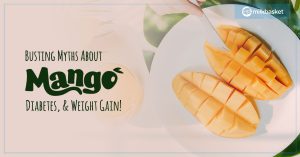
5 Common Myths About Mango
Spread the loveMango has been grown and eaten in India for thousands of years. Families look forward to the summer season only to be able to eat tasty, juicy, sweet & sour mangoes. These stone fruits aren’t just delicious but also provide various health benefits. However, people are often skeptical about eating mangoes due to […]
16 Jun 2023 read More... -

Mango Juice Recipe – Easy & Homemade
Spread the loveThe mango is a tropical stone fruit believed to have originated in the Indian subcontinent. People of Southeast Asia have been cultivating this fruit for thousands of years. Rich in nutrition and loved for their sweet, juicy, and tangy taste, they are eaten raw, cooked, pickled, preserved, and juiced. In this blog post, […]
24 May 2023 read More... -
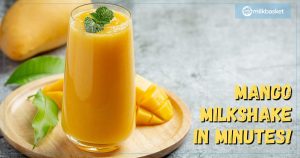
Mango MilkShake Recipe – Easy & Homemade
Spread the loveHey mango lovers! 🥭 Are you feeling the summer heat & in need of a cool & fruity drink? Well, we’ve got just the thing for you – a lip-smacking mango shake recipe! Whether you’re a die-hard fan of mangoes or just looking for a new summer beverage, this recipe is guaranteed to […]
12 May 2023 read More... -

10 Refreshing Summer Drinks To Beat The Heat
Spread the loveAs the temperature rises during summer, it’s important to stay hydrated and cool. One of the best ways to do this is by indulging in delicious and refreshing summer drinks that not only quench your thirst but also provide essential nutrients to keep you going all day. Here are some of the best […]
03 Apr 2023 read More... -

Milkbasket’s Latest DVC Campaign Is Out, And It’s Quirky And Relatable As Heck!
Spread the loveThe year 2021 was all about patience, resilience, and the grind it takes to get back up from a worldwide slump that the COVID-19 pandemic had hit us with. It made us all revisit our roots, recalibrate our priorities, and strengthen our foundations. With the better part of 2022 gone into slowly spreading […]
28 Sep 2022 read More... -

Milkbasket – A Revolution In The Online Grocery Delivery Services In India
Spread the loveThere’s no denying the fact that the pandemic has drastically changed the way people spend their time online, buying everything through various online retail platforms with the convenience of home deliveries in India. Milkbasket, with it’s features has proven to be a revolution in the online grocery delivery services in India. While stepping […]
08 Jul 2022 read More... -

Nabhi Chikitsa or Belly Button Therapy: The Simple Health Secret You NEED To Know!
Spread the loveOur Navel or Belly Button (scientific name Umbilicus) is believed to be the centre of our life force. Most of us take it as just another part of our body not knowing its deep, thrilling world. In ancient Hindu healing practices, the Navel is considered to be the most important point of the […]
08 Sep 2022 read More... -

Recycling At Milkbasket: A World Environment Day Special
Spread the loveAs people who serve and bring convenience to other people, it’s important for us as brands to give a thought from time to time to what matters the most to us as human beings. The realization of the countless resources that our planet has provided us allows us to be amazed and humbled […]
05 Jun 2022 read More...

